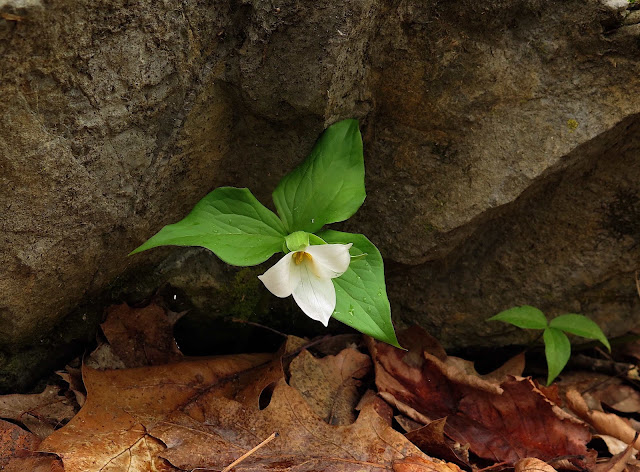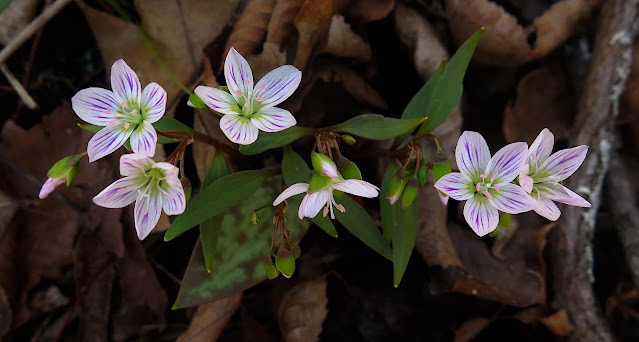It's Earth Day today. And here I sit, indoors at my computer. But that's because I've been outdoors nearly every day this past week, trying to keep up with the floral explosion caused by last week's unseasonable heat, and I'm wading through the flurry of my photos to clear my camera for what's bound to be blooming this coming week. And just for the phenological record, I want to record on this blog what I've found in bloom this past week.
Here's just a sampling of Mother Earth's marvels, and from only two of this past week's outing locations.
Cottage Park Trail, Moreau Lake State Park, April 15 and 20
One of the nicer features about this woodland-to-mountaintop trail is that its trailhead lies just across the road from the Hudson River. The river here is beautiful in every season, calmed and widened by being held between the Spier Falls and Sherman Island dams and dotted with small wooded islands. But the Luzerne Mountains that rise from the far bank are never lovelier than in spring, when the soft pastels of the newly leafing-out hardwood trees are punctuated by the deep greens of the conifers.
I'm joined in my explorations today (April 15) with my wonderful fellow nature explorers Sue Pierce (left) and Ruth Brooks. We are scouting the trail for when Sue will lead our Thursday Naturalist friends on an outing here on April 20.
The name of the trail, Cottage Park, stems from when this region of the woods held housing for the many workers and project managers constructing the nearby Spier Falls Dam on the Hudson River, the largest privately-owned hydroelectric dam in the nation at the time of its completion in 1903. The stone foundations are all that remains of this housing, but the stones themselves now provide habitat for numerous beautiful mosses. Both Sue and Ruth are moss enthusiasts, so we spend quite a bit of time here examining what's growing on the rocks.
Our destination today is not the peaks of the Palmertown Mountains (to which the Cottage Park Trail eventually ascends), but rather via a spur trail to a stream-crossed vale that lies at the foot of steeply ascending bedrock. One of the most monumental outcroppings is topped by a lush population of Foamflower plants (Tiarella sp.), whose leaf-adorned stolons drape across the face of the rock like bead curtains.

Until I noticed these draping stolons last year and posted a photo of them on Facebook (where some knowledgable botanists responded), I had not realized that the scientific name of our regional species of Tiarella was in the process of being reassigned, from T. cordifolia to T. stolonifera. Stolons are creeping horizontal plant stems that take root at points along their lengths to form new plants. This photo below shows a closer look at a Foamflower stolon. In addition to the presence or absence of stolons, the main features distinguishing several Tiarella species are the shape of the basal leaves, and the presence or absence of leaves on the flowering stem.
I found online
an article that presents some of the botanical discussions surrounding the reassignment of our northern species of Foamflower.
That marvelous rocky outcropping supports abundant numbers of other interesting plants, including the kinds of mosses that kept Ruth riveted to her rock-side seat for quite a while.
Ruth also found this delightfully curly moss on an isolated rock lying on the forest floor. Its scientific name is Thamnobryum alleghaniense. It's also called Shrub Moss, supposedly because the individual plants look like miniature trees with flattened branches arching down from the top of secondary stems. In a damp shady habitat like this one, though, the plants lose their treelike upright posture and sprawl across the face of the ground or rock.
On our way to this rocky outcropping site, we passed through a mixed hardwood/conifer woods that held more Striped Maple trees (Acer pensylvanicum) than I have ever seen in one place. On our first visit (April 15), these understory trees were holding big velvety buds erect as candle flames throughout the forest.
By the time we returned 5 days later, those buds had opened to release bright-green leaves, so there appeared to be flocks of pink-bodied, green-winged birds flitting through the forest.
One of the best reasons we chose this Cottage Park Trail for a Thursday Naturalists' outing was because of the remarkable abundance of beautiful spring wildflowers that thrive at this location. On our first visit, just a few of the lovely pink-striped blooms of Carolina Spring Beauty (Claytonia caroliniana) were beginning to open. When we returned on April 20, we had to step carefully, so numerous were the flowers scattered across the forest floor.
Not quite so numerous but yet abundant, too, were many plants of Dutchman's Breeches (Dicentra cucullaria). Still mostly in bud on our preview walk, they were fully in bloom when we returned on April 20.
The budding Red Trilliums (Trillium erectum) too, had opened wide their crimson flowers five days later.
And the tight buds of Round-leaved Violets (Viola rotundifolia) we'd found on the 15th were fully in bloom when we returned with our Thursday Naturalist friends on the 20th.
In just those five days, though, the fluffy yellow male flowers of Pennsylvania Sedge (Carex pensylvanica) had faded to beige, having already shed their pollen on the white thready female flowers below them on the stems. I'm glad I captured their sprightly beauty on our preview visit.
Very few fungi sprout as early in spring as does the vivid Scarlet Cup (Sarcoscypha coccinea). It's a nicely persistent one, too, looking just as brightly red and intact when we returned on the 20th as it did the day we found it on the 15th. It was like a cherry atop the pleasure of our two visits to this marvelous location.
North Woods at Skidmore College, April 21
Another beautiful balmy day, and what better way to spend it than walking with my friends (L-R) Ruth Brooks, Tom Callaghan, and Dana Stimpson through the limestone underlaid woods at Skidmore College? I had been here just a week ago to find only a few hepaticas in bloom. What would we find today, after those days of extreme heat followed by some rainy cool ones?
The first surprise was to find some Large-flowered Bellwort (Utricularia grandiflora) dangling big yellow flowers already. Wait! Don't the Sessile-leaved Bellworts bloom first?
Well, this year those two bellworts are sharing the same bloom time. Although the U. grandiflora are more abundant in this woods, we did find a few of the Sessile-leaved Bellworts (U. sessilifolia) hiding out beneath the trunks of trees.
Another surprise! The yellow-flowered, delicate-leaved Blue Cohosh (Caulophyllum thalictroides) was blooming already. I usually have to wait at least a week after finding the Early Blue Cohosh (C. giganteum) blooming before I find these blooming nearby. And those I had yet to see.
But there they were! Just a few yards away and from all appearances, the Early Blue Cohosh (C. giganteum) were just beginning to bloom, with their dark purple leaves yet unfurled, while the dark purple flowers were already sprouting ripe pollen. This seems quite backward from usual years, when C. giganteum precedes C. thalictroides by at least a week. What a crazy year!
I was not expecting to find any Bloodroot (Sanguinaria canadensis) today, since I know it to be such a brief bloomer and I'd already found some blooming a week ago. But a few did persist in flower, even though most plants were already holding jade-green seed pods aloft.
Darn, but even most of the Trout Lily flowers (Erythronium americanum) were looking a little past peak! I felt lucky to find this lovely patch of them in their prime, perhaps protected by the tree roots from last week's unseasonable heat.
True to my expectations, most hepaticas, whether Round-lobed or Sharp-lobed, were already fading. That's why this gorgeous deep-purple bloom was such a surprising treat, especially since other hepatica plants had already gone to seed.
But I think hepatica's seed pods are almost as pretty as the flowers, a sphere of spiky little seeds set within a trio of green bracts.
The most flourishing flowers we found today were the Long-spurred Violets (Viola rostrata), some plants just opening their buds, others in full bloom, like this lovely bunch of purple flowers. Some plants held blooms so pale they appeared nearly white, and other plants held pied blooms mottled pale-purple and white. But all of these color variations featured a darker purple at the center, a distinctive trait of this native violet species.
Other violets blooming now in this woods included the Downy Yellow Violet (Viola pubescens), a species that bears its leaves and flowers on the same stems. This helps to distinguish this violet from the other yellow violet blooming now (or earlier), the Round-leaved Violet, which has basal leaves only.
Most of the Canada Violet plants (Viola canadense) that crowded areas littered with limestone rocks had yet to produce any flowers. So this single yellow-centered white bloom was a delightful treat. I also was glad to see the buds showing purple, a color that continues to tinge the back of the Canada Violet's pure-white petals even after the flowers open wide.
Did you notice the tiny reddish fiddleheads poking up amid the Canada Violet's leaves in the photo above? Those are the first shoots of the Bulblet Ferns (Cystopteris bulbifera) that flourish atop the craggy limestone rocks littering this area of the forest floor. Here's a frond that has unfurled a bit more, displaying the translucent red stalks that remind me of Cherry Twizzlers. When mature, this species of fern (which prefers calcareous habitats like this) will reproduce via both spores and clonal bulblets. Hence the name Bulblet Fern.

Many plants of Wild Ginger (Asarum canadense) also inhabit the limey rocks here, their small brownish flowers pressing close to the rock. I usually have to push aside the large heart-shaped green leaves to espy the single flower, but this one showed its face to me quite openly. I imagine because it usually hides its flower beneath the leaves and lies flat on the ground where hardly any pollen could be wafted about, that it prefers to be pollinated by ants and other insects that crawl on the forest floor. The abundant patches I find in this woods seem to indicate it has few problems in reproducing, at least in the right habitat.
One of the nicest things about Red Trillium (Trillium erectum) is its long bloom time. Even though I found some blooming at a nearby site a week ago, the ones I saw in the Skidmore woods on this day looked as lovely as ever.
And here was the promise of more Trillium beauty to come -- and lots and lots of it! Although only one of the many Large-flowered White Trilliums (Trillium grandiflorum) sprouting up now bore a flower as open as this, hundreds more will be carpeting the forest floor in the weeks to come. And I do mean weeks. Usually, anyway, barring unusual heat. Then a week of big white flowers will be followed by an ample period of pink blooms as the flowers fade.
Lots more lovely plants to come in the weeks ahead. I feel very grateful to live in such wildflower heaven!























































